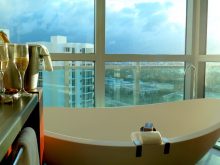First of all, have the car drive you around to the 20th Street entrance, back by the cul de sac near the ocean—so that you enter on the residential side of the Setai complex, the side with the 40-story tower—whereupon you’ll proceed through a somewhat unprepossessing pair of walnut doors and into an understated lobby where the concierge will direct you through another pair of sublimely crafted walnut doors—and out into the balmy Miami air.
Take a deep breath as you stroll under a pergola along a peaceful walkway lined with contemplation pools and open-air conversation-and-cocktail pods. And then through another set of doors—into a jaw dropping, awe-inspiring courtyard with a massive reflecting pool surrounded by banquette seating, Zen stones, statuary, candlelight and plantings. The proportions are staggering—and just as inspiring, there’s an equally impressive calm about the courtyard. Something about this space provokes respect—and a correspondent reverent behavior, the kind perhaps more often witnessed within great cathedrals or Japanese temples.
Originally built between 1936-38 as the Dempsey Vanderbilt Hotel, The Restaurant at the Setai rings the reflecting pool courtyard and is divided into three areas—the Grill, the Bar, and the Restaurant—each one flowing naturally into the other. To walk the periphery of the reflecting pool and then into the Bar and along a vast hall carpeted with Asian rugs and then around a corner to the maitre d’ who escorts you to your table is to feel you have arrived—finally, happily—at your destination. Here you are, at last, where you want to be: where the beautifully-laid tables are perfectly spaced, as if to enhance the art of thoughtful conversation—as well as perfectly sized to accommodate the refined table settings.
As for the food, there’s an amuse-bouche to commence: a cordial of aspic topped with cauliflower cream which is both unctuous and refreshing. And then a salad of Asian pear with young organic vegetables and shoots, drizzled with a ginger vinaigrette and a dollop of green apple foam, where the textures complement as satisfyingly as the contrasting tastes. For an entrée, it’s Gaeng Kheow Wan Gai, which apparently, roughly translates to fried bean curd with mixed Thai eggplant and bamboo shoots—artfully presented on a rectangular lacquer plate and a handmade pottery bowl. The fragrance is astonishing—rising above the table and enveloping us in a fantasy of an idyllic Thai island. There’s a wine pairing for each course—moving us from a French Sancerre to a Napa Chardonnay—and then on to dessert: a Kaffir lime leaf parfait with fresh toasted coconut and sapelot.
We linger long after the final bite. We luxuriate in the spell. We listen to each other and consider what we’re saying. There’s a kind of acute presence which has taken over—enabling us to be in the here and now—and to appreciate the serenity within and without. Few places, and even fewer restaurants, provide solace for the soul as well as sating the palate. The Restaurant at the Setai revives faith: in the joy of eating and the good intentions that can follow from eating well.






